Tippmann is an American manufacturer of paintball markers and paintball equipment, including military simulation (MilSim) kits. A related company, Tippmann Industrial Products manufactures manual and pneumatic heavy-duty sewing machines primarily used for leather, other leather-related equipment, and some industrial products. Originally a family-owned business run from Fort Wayne, Indiana, in 2004 Dennis Tippmann Sr. sold a majority ownership stake to Summit Partners, a private equity firm. Tippmann designed one of the first automatic markers, the use of refillable air systems in place of 12 gram cartridges, the "Cyclone Feed" system, the "Flatline" barrel, and the Tippmann C-3, the first propane-powered marker.
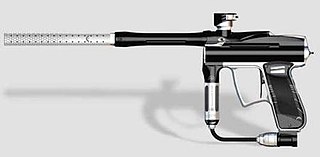
The Angel is one of the first electropneumatic paintball markers. It was manufactured by Angel Paintball Sports starting in 1997 and was introduced alongside Smart Parts' original Shocker.
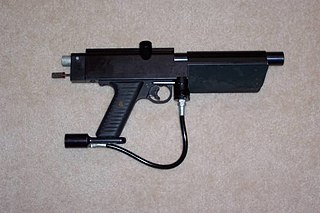
The Autococker is a closed-bolt semiautomatic paintball marker manufactured by Worr Game Products (WGP). It was one of the first paintball markers to be designed specifically for the sport, and has long been known throughout the paintball community for its popularity and customizability as well as its complexity. It is commonly believed that the closed-bolt design of the marker makes it inherently more accurate than its open-bolt counterparts, though this is disputed.
Smart Parts was a paintball manufacturing company in Latrobe, Pennsylvania, which filed for liquidation on July 28, 2010. As of August 22, 2010 Smart Parts' assets and intellectual property were acquired by Kee Action Sports.

A solenoid valve is an electromechanically operated valve.

A paintball marker, also known as a paintball gun, paint gun, or simply marker, is an air gun used in the shooting sport of paintball, and the main piece of paintball equipment. Paintball markers use compressed gas, such as carbon dioxide (CO2) or compressed air (HPA), to propel dye-filled gel capsules called paintballs through the barrel and quickly strike a target. The term "marker" is derived from its original use as a tool for forestry personnel to mark trees and ranchers to mark wandering cattle.
Paintball is an equipment-intensive sport and in order to safely conduct a game, every player requires a marker with propellant to fire the paint, a mask to protect the eyes and face, paintballs, and a loader to hold them. To ensure safety off the playing field, a barrel sock or plug for the marker is also compulsory.
A ball detent is a simple mechanical arrangement used to hold a moving part in a temporarily fixed position relative to another part. Usually the moving parts slide with respect to each other, or one part rotates within the other.
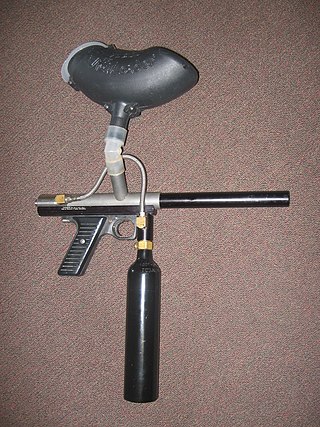
The Automag is a paintball marker designed by Tom Kaye and produced by Airgun Designs, Inc. It bears the distinction of being the first semi-automatic marker ever to win a paintball tournament. Team Swarm used Automags in their victory at the 1990 International Masters.
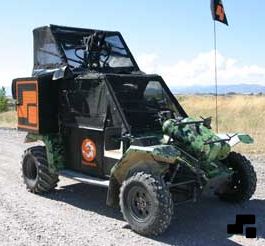
A paintball tank, also known as a paintball armoured vehicle, (pav), is a vehicle, or a portable structure that resembles a vehicle, sometimes used in the sport of paintball, usually with the intent of military simulation. The purpose of the tank is to provide a mobile shelter for one or several players, from which they may employ their markers against players on the opposing team. Small pneumatic guns, effectively low-powered potato cannons loaded with foam darts, are also often employed against other tanks.
The Quadrajet is a four barrel carburetor, made by the Rochester Products Division of General Motors. Its first application was the new-for-1965 Chevy 396ci engine. Its last application was on the 1990 Oldsmobile 307 V8 engine, which was last used in the Cadillac Brougham and full size station wagons made by Chevrolet, Pontiac, Oldsmobile, and Buick.
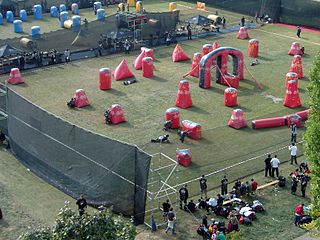
Speedball is one of the three distinct game variants in the sport of paintball, along with woodsball and scenario paintball.
The CCI Phantom is a Nelson-based pump action paintball marker developed and produced by Mike Casady. Production began in 1987 after about six months of prototype work. The name for the marker was derived from the much more stealth-oriented and drawn-out style of play that was typical when the game was first developing. The Phantom was designed to be powered by a single 12-gram CO2 Powerlet, but larger tanks may also be used by removing the powerlet adapter or using a dummy powerlet. When first introduced the marker featured a fixed barrel assembly referred to as a "unibody" combined with a modified Crosman air pistol frame and brass bead sight. However, since roughly 1989 the body and barrel of the marker have been two distinct parts and no longer feature the bead style sight. The marker is also capable of supporting bulk gravity fed hoppers by using a different breach type. The Phantom is one of only a handful of readily available markers acceptable for use in the various forms of stock class paintball. However, because the Phantom is capable of auto-triggering and features barrel porting it is considered to be a modified stock class marker.
The PGP is a paintball pistol originally manufactured by Benjamin Sheridan Air Rifle Co.. It is one of the earliest paintball markers ever created.. It is a "Stock Class" paintball marker, meaning that it utilizes 12-gram CO2 powerlets, and has a horizontal feed tube that holds 10 paintballs, and is considered a classic exemplar of the design.

DYE Precision, also known as simply DYE, is a paintball equipment manufacturing company and a well known Numerical control (CNC) manufacturing company operated under the brand DYE CNC based in California. Dave Dehaan started the company by producing barrels for paintball markers, using his garage as a workshop. He supplied barrels to the California Ironmen and Team Avalanche, who at that time were two of the most dominant teams in Professional paintball. From these humble beginnings, DYE went on to become an International concern that went on to manufacture an extensive range of paintball markers, loaders, playing & casual clothing, protective gear, goggles and luggage and created an economy focused offshoot brand Proto Paintball. Their range of products is typically updated each year. In 2005, the company was praised as one of the industry's largest paintball manufacturers. The company has offices in London, Taiwan and Germany.

A potato cannon is a pipe-based cannon that uses air pressure (pneumatic), or combustion of a flammable gas, to launch projectiles at high speeds. They are built to fire chunks of potato, as a hobby, or to fire other sorts of projectiles, for practical use. Projectiles or failing guns can be dangerous and result in life-threatening injuries, including cranial fractures, enucleation, and blindness if a person is hit.

FEP Sports, formally known as First Endeavor Paintball or FEP, is a developer and manufacturer of paintball markers and other equipment located in Oxnard, CA. FEP is best known for their flagship Quest marker and associated upgrades. The company was created in 2004 and has existed as medium-sized entity since that time with the intention of supporting a limited array of products and services. The company was disbanded in 2007, but later resurrected under new staff in 2009. As of 2009, FEP Sports is currently involved in an internal restructuring to accompany their development phase related to their new upcoming products.
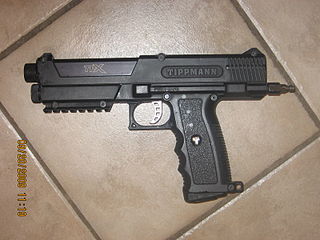
The TPX/TiPX is a magazine fed paintball pistol made by Tippmann. New to the paintball pistol market, Tippmann released the TPX in 2009. This paintball marker uses an air system that allows for 12 gram CO2 cartridges to be placed underneath the barrel. This was meant to eliminate bulk in the grip of the marker caused by placing the CO2 cartridge in the magazines. In 2011,Tippmann changed the name of the pistol to the TiPX to market all the improved parts at that time, as well as differentiate it from the TPX baseball line by Louisville Slugger.
RAP4 is a manufacturer of paintball markers, paintball equipment, tactical gear and training tools.

An electropneumatic paintball marker is a paintball marker that uses a pneumatic solenoid to actuate the hammer and/or bolt's movement.












